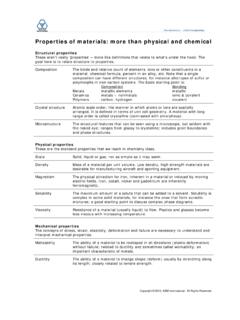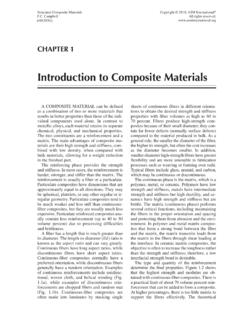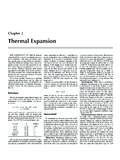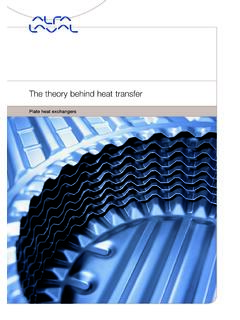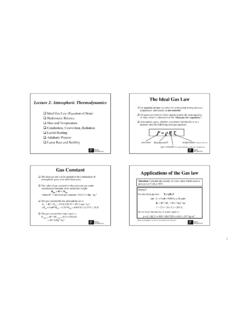Transcription of SUBJECT GUIDE Heat Treating - ASM International
1 Materials Park, Ohio 44073-0002 :: :: :: by ASM International :: Data shown are typical, not to be used for specification or final design. SUBJECT GuideCopyright 2015, ASM International . All rights reserved. SUBJECT GUIDE1 heat TreatingOverviewHeat Treating , as the name implies, is a series of treatments in which heat is used to alter the properties of a metal or alloy. Because time at temperature is also important, heat treatment can be further defined as a series of time-temperature treat-ments. heat treatments are used for a variety of purposes, the most important being to control the mechanical properties, especially hardness, ductility, strength, toughness, and internal is the resistance of a material to plastic indentation.
2 Hardness values are roughly proportional to the strength of a metal and can give an indication of the wear properties of a mate-rial. Hardness values can be useful during the materials selection process and for quality-control evaluations, but the values can-not be applied directly during the design of a part. Ductility is the capability of a material to deform plastically with-out fracturing, and it is usually measured by the amount that a bar under tensile load will elongate before fracturing. The elonga-tion is expressed as a percentage of the original length of the is the ability of a material to withstand an applied force, and three types are commonly discussed. Elastic strength, referred to as the elastic limit, is strength before the material deforms permanently.
3 The yield strength is the strength of a material before appreciable plastic deformation occurs. The ultimate tensile strength is the maximum strength that a metal exhibits during tensile is the ability of a metal to absorb energy in the plas-tic range. Although there are a number of approaches for defin-ing toughness, one of the oldest is to consider it as the total area under the stress-strain curve. This area is an indication of the amount of work per unit area that can be done without causing it to fail. Because toughness is the area under the stress-strain curve, it is a function of both strength and or locked-in stresses arise in components from many sources and, if left untreated, can lead to component distortion, stress concentration, and failure.
4 One of the most common causes of residual stresses is nonuniform cooling from elevated tempera-tures. On cooling, the surface cools quickly and contracts, while the inner core remains hotter longer and cools more slowly, thus setting up residual stresses. Components are heated to a suitable temperature and held at temperature for a time long enough to reduce residual stresses and are then cooled slowly enough so that new residual stresses are not are many types of heat treatment processes, some of which are applied only to steels and others that are applied only to other alloys. heat treatment processes can be classified into four general categories: Annealing (softening) Hardening Surface hardening MiscellaneousAnnealingWhen a metal is cold worked (deformed at room temperature), the microstructure becomes severely distorted because of an increased dislocation density resulting from the deformation.
5 Cold working is also referred to as work hardening or strain hardening. As a metal is cold worked, the strength and hardness increase while ductility decreases. Eventually, it is necessary to anneal the piece to allow further forming operations without the risk of breaking it. In addition, some metals are strengthened pri-marily by cold working. In this case, it is important that the metal not soften appreciably when placed in service. Cold-worked materials with highly distorted microstructures are in a high-energy state and are thermodynamically unstable. Annealing is the heat treatment process that softens a metal that has been hardened by cold working. Annealing consists of three stages: recovery, recrystallization, and grain growth.
6 Although a reduction in stored energy provides the driving force, anneal-ing usually does not spontaneously occur at room temperature. Because the reduction in stored energy must occur by diffusion, the activation energy needed to start the diffusion process is normally insufficient at room temperature. Therefore, heating is necessary to provide the thermal activation energy needed to transform the material to a lower-energy state. As the internal lat-tice strains are relieved during annealing, the strength decreases while the ductility increases. It should be noted that some low-melting-point metals have recrystallization temperatures lower than room temperature and cannot be hardened by cold working. For example, lead, tin, and zinc have recrystallization tempera-tures below room three distinct processes that occur during annealing recov-ery, recrystallization, and grain growth are described as During recovery, there is a rearrangement of internal defects, known as dislocations, into lower-energy configurations; however, the grain shape and orientation remain the same.
7 There is also a significant reduction in residual stresses, but the strength and ductility are largely unaffected. Because there is a large decrease in residual stress during recovery, recovery-type pro-cesses are usually conducted to reduce residual stresses, often to prevent stress-corrosion cracking or minimize distortion. During stress-relief operations, the temperature and time are controlled so there is not a major reduction in strength or Park, Ohio 44073-0002 :: :: :: by ASM International :: Data shown are typical, not to be used for specification or final design. SUBJECT GuideCopyright 2015, ASM International . All rights reserved. SUBJECT GUIDEHeat Treating2 Recrystallization is characterized by the nucleation and growth of strain-free grains out of the matrix of the cold-worked metal.
8 During recrystallization, the badly deformed cold-worked grains are replaced by new, strain-free grains. New orientations, new grain sizes, and new grain morphologies form during recrystal-lization. The driving force for recrystallization is the remain-ing stored energy that was not expended during recovery. The strength reduces and the ductility increases to levels similar to those of the metal before cold is considered complete when the mechanical properties of the recrystallized metal approach those of the metal before it was cold worked. Recrystallization and the resulting mechanical softening completely cancel the effects of cold work-ing on the mechanical properties of the piece. An annealing curve for an alloy, such as a typical brass, will show minimal changes in mechanical properties during recovery and large changes in properties that occur during recrystallization (Fig.)
9 1). Mechanical properties, such as hardness, yield strength, tensile strength, per-cent elongation, and reduction in area, change drastically over a very small temperature range. Although physical properties, such as electrical conductivity, undergo large increases during recov-ery, they also continue to increase during recrystallization. Grain growth is the growth of some recrystallized grains, and it can only happen at the expense of other recrystallized grains. Because fine grain size leads to the best combination of strength and ductility, in almost all cases, grain growth is an undesirable process. Although excessive grain growth can occur by holding the material for too long at the annealing temperature, it is usu-ally a result of heating at too high a steel- specific annealing heat treatments include normal-izing, spheroidizing, and solution annealing, which is described as annealing, sometimes referred to as quench anneal-ing, is an important category of annealing.
10 The heat treatment is called solution annealing because the heat treatment takes advantage of the solid-solution regions of the iron-carbon phase diagram (for steels) or, in the case of nonferrous alloys, the phase diagrams for the major components of the alloy system (see the topic summary Phase Diagrams ).For steels, solution annealing involves heating to a sufficiently high temperature for a sufficiently long time to drive free carbides into solid solution and then rapidly quenching to freeze them. The resulting steel has improved formability, and corrosion resis-tance to certain acids can be nonferrous alloys, solution annealing is a preliminary step to hardening of the alloys. The solution heat treatment involves heating the alloy to a high enough temperature to drive the alloy-ing elements into solid solution, yielding a metastable, supersatu-rated solid solution.
